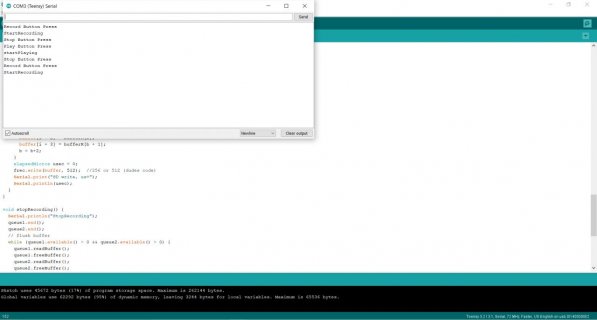Hey All-
I've been trying to use the recorder example sketch to validate recording to an SD card with a Teensy 3.2 and the audio shield's line in. The SD card reads fine with the CardInfo sketch but the Teensy never records to the SD card. I've tried reformatting the SD card but had no luck. At this point I'm thinking I should try a whole new SD card.
Anyone ever have similar issues with the Recorder example sketch not writing to the SD card
I've been trying to use the recorder example sketch to validate recording to an SD card with a Teensy 3.2 and the audio shield's line in. The SD card reads fine with the CardInfo sketch but the Teensy never records to the SD card. I've tried reformatting the SD card but had no luck. At this point I'm thinking I should try a whole new SD card.
Anyone ever have similar issues with the Recorder example sketch not writing to the SD card
Code:
// Record sound as raw data to a SD card, and play it back.
//
// Requires the audio shield:
// http://www.pjrc.com/store/teensy3_audio.html
//
// Three pushbuttons need to be connected:
// Record Button: pin 0 to GND
// Stop Button: pin 1 to GND
// Play Button: pin 2 to GND
//
// This example code is in the public domain.
#include <Bounce.h>
#include <Audio.h>
#include <Wire.h>
#include <SPI.h>
#include <SD.h>
#include <SerialFlash.h>
// GUItool: begin automatically generated code
AudioInputI2S i2s2; //xy=105,63
AudioAnalyzePeak peak1; //xy=278,108
AudioRecordQueue queue1; //xy=281,63
AudioPlaySdRaw playRaw1; //xy=302,157
AudioOutputI2S i2s1; //xy=470,120
AudioConnection patchCord1(i2s2, 0, queue1, 0);
AudioConnection patchCord2(i2s2, 0, peak1, 0);
AudioConnection patchCord3(playRaw1, 0, i2s1, 0);
AudioConnection patchCord4(playRaw1, 0, i2s1, 1);
AudioControlSGTL5000 sgtl5000_1; //xy=265,212
// GUItool: end automatically generated code
// For a stereo recording version, see this forum thread:
// https://forum.pjrc.com/threads/46150?p=158388&viewfull=1#post158388
// A much more advanced sound recording and data logging project:
// https://github.com/WMXZ-EU/microSoundRecorder
// https://github.com/WMXZ-EU/microSoundRecorder/wiki/Hardware-setup
// https://forum.pjrc.com/threads/52175?p=185386&viewfull=1#post185386
// Bounce objects to easily and reliably read the buttons
Bounce buttonRecord = Bounce(0, 8);
Bounce buttonStop = Bounce(1, 8); // 8 = 8 ms debounce time
Bounce buttonPlay = Bounce(2, 8);
// which input on the audio shield will be used?
const int myInput = AUDIO_INPUT_LINEIN;
//const int myInput = AUDIO_INPUT_MIC;
// Use these with the Teensy Audio Shield
#define SDCARD_CS_PIN 10
#define SDCARD_MOSI_PIN 7
#define SDCARD_SCK_PIN 14
// Use these with the Teensy 3.5 & 3.6 SD card
//#define SDCARD_CS_PIN BUILTIN_SDCARD
//#define SDCARD_MOSI_PIN 11 // not actually used
//#define SDCARD_SCK_PIN 13 // not actually used
// Use these for the SD+Wiz820 or other adaptors
//#define SDCARD_CS_PIN 4
//#define SDCARD_MOSI_PIN 11
//#define SDCARD_SCK_PIN 13
// Remember which mode we're doing
int mode = 0; // 0=stopped, 1=recording, 2=playing
// The file where data is recorded
File frec;
void setup() {
// Configure the pushbutton pins
pinMode(0, INPUT_PULLUP);
pinMode(1, INPUT_PULLUP);
pinMode(2, INPUT_PULLUP);
// Audio connections require memory, and the record queue
// uses this memory to buffer incoming audio.
AudioMemory(60);
// Enable the audio shield, select input, and enable output
sgtl5000_1.enable();
sgtl5000_1.inputSelect(myInput);
sgtl5000_1.volume(0.5);
// Initialize the SD card
SPI.setMOSI(SDCARD_MOSI_PIN);
SPI.setSCK(SDCARD_SCK_PIN);
if (!(SD.begin(SDCARD_CS_PIN))) {
// stop here if no SD card, but print a message
while (1) {
Serial.println("Unable to access the SD card");
delay(500);
}
}
}
void loop() {
// First, read the buttons
buttonRecord.update();
buttonStop.update();
buttonPlay.update();
// Respond to button presses
if (buttonRecord.fallingEdge()) {
Serial.println("Record Button Press");
if (mode == 2) stopPlaying();
if (mode == 0) startRecording();
}
if (buttonStop.fallingEdge()) {
Serial.println("Stop Button Press");
if (mode == 1) stopRecording();
if (mode == 2) stopPlaying();
}
if (buttonPlay.fallingEdge()) {
Serial.println("Play Button Press");
if (mode == 1) stopRecording();
if (mode == 0) startPlaying();
}
// If we're playing or recording, carry on...
if (mode == 1) {
continueRecording();
}
if (mode == 2) {
continuePlaying();
}
// when using a microphone, continuously adjust gain
if (myInput == AUDIO_INPUT_MIC) adjustMicLevel();
}
void startRecording() {
Serial.println("startRecording");
if (SD.exists("RECORD.RAW")) {
// The SD library writes new data to the end of the
// file, so to start a new recording, the old file
// must be deleted before new data is written.
SD.remove("RECORD.RAW");
}
frec = SD.open("RECORD.RAW", FILE_WRITE);
if (frec) {
queue1.begin();
mode = 1;
}
}
void continueRecording() {
if (queue1.available() >= 2) {
byte buffer[512];
// Fetch 2 blocks from the audio library and copy
// into a 512 byte buffer. The Arduino SD library
// is most efficient when full 512 byte sector size
// writes are used.
memcpy(buffer, queue1.readBuffer(), 256);
queue1.freeBuffer();
memcpy(buffer+256, queue1.readBuffer(), 256);
queue1.freeBuffer();
// write all 512 bytes to the SD card
//elapsedMicros usec = 0;
frec.write(buffer, 512);
// Uncomment these lines to see how long SD writes
// are taking. A pair of audio blocks arrives every
// 5802 microseconds, so hopefully most of the writes
// take well under 5802 us. Some will take more, as
// the SD library also must write to the FAT tables
// and the SD card controller manages media erase and
// wear leveling. The queue1 object can buffer
// approximately 301700 us of audio, to allow time
// for occasional high SD card latency, as long as
// the average write time is under 5802 us.
//Serial.print("SD write, us=");
//Serial.println(usec);
}
}
void stopRecording() {
Serial.println("stopRecording");
queue1.end();
if (mode == 1) {
while (queue1.available() > 0) {
frec.write((byte*)queue1.readBuffer(), 256);
queue1.freeBuffer();
}
frec.close();
}
mode = 0;
}
void startPlaying() {
Serial.println("startPlaying");
playRaw1.play("RECORD.RAW");
mode = 2;
}
void continuePlaying() {
if (!playRaw1.isPlaying()) {
playRaw1.stop();
mode = 0;
}
}
void stopPlaying() {
Serial.println("stopPlaying");
if (mode == 2) playRaw1.stop();
mode = 0;
}
void adjustMicLevel() {
// TODO: read the peak1 object and adjust sgtl5000_1.micGain()
// if anyone gets this working, please submit a github pull request :-)
}



